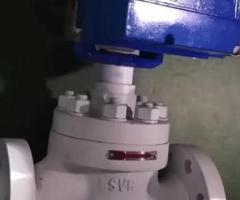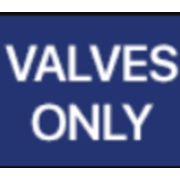Valvesonly is a leading Control Valve Supplier in USA. A control valve is a crucial component in fluid control systems, designed to regulate the flow of fluid (such as gas, steam, or liquid) within a piping system. Its primary function is to control the rate of flow, pressure, temperature, or liquid level by modulating the opening or closing of the valve. The structure of a control valve typically consists of several key components: the valve body, actuator, positioner, and control signal.
The valve body contains the internal mechanism responsible for regulating the flow of fluid. It contains the movable element, such as a disk, ball, or plug, which can be adjusted to alter the flow passage. The actuator is th...
Valvesonly is a leading Control Valve Supplier in USA. A control valve is a crucial component in fluid control systems, designed to regulate the flow of fluid (such as gas, steam, or liquid) within a piping system. Its primary function is to control the rate of flow, pressure, temperature, or liquid level by modulating the opening or closing of the valve. The structure of a control valve typically consists of several key components: the valve body, actuator, positioner, and control signal.
The valve body contains the internal mechanism responsible for regulating the flow of fluid. It contains the movable element, such as a disk, ball, or plug, which can be adjusted to alter the flow passage. The actuator is the driving force behind the movement of this element and can be pneumatic, hydraulic, or electrically powered. It converts the control signal, usually from a controller or computer, into mechanical motion to position the valve accordingly. The positioner ensures precise control by accurately positioning the valve based on feedback signals. Together, these components work in tandem to adjust the flow rate and maintain the desired process conditions within the system. Control valves are utilized across various industries, including oil and gas, chemical processing, power generation, and water treatment, to ensure optimal operation and efficiency of fluid systems.
Parts:
• Valve Body
• Trim
• Actuator
• Positioner
• Bonnet
• Stem
• Packing
We Supply wide range of Control Valve like:
• Pneumatic Angle Seat Control Valve
• Electric Control Valve
• Type shutoff control valve
• Globe Control valve
• Cage type control valve
• Single Seat control valve
• Double seat control valve
• Three-way control valve
• Water Control valve
Advantages:
• These valves enable precise regulation of flow rate, pressure, temperature, or liquid level within a process. This precision allows for fine-tuning of process parameters, resulting in optimized system performance and increased efficiency.
• They can be configured and adjusted to meet specific process requirements. They offer flexibility in terms of flow control range, response time, and operating conditions, making them suitable for a wide range of applications across different industries.
• By maintaining consistent process conditions, control valves help improve process stability and reduce fluctuations in output quality. This leads to enhanced product consistency and reliability in manufacturing processes.
• Control valves contribute to energy conservation by regulating flow rates and pressure drops within the system. By adjusting the valve position based on process demand, energy consumption can be optimized, resulting in cost savings and reduced environmental impact.
• Many control valves can be integrated with control systems and automation technologies, allowing for remote monitoring and control. This capability enhances operational efficiency, reduces manual intervention, and enables real-time adjustments to process conditions.
• They play a crucial role in maintaining safe operating conditions within a system. They can be equipped with safety features such as fail-safe mechanisms, emergency shut-off capabilities, and pressure relief valves to prevent accidents and protect equipment and personnel.
• High-quality control valves are built to withstand harsh operating environments and prolonged use. With proper maintenance and servicing, they can offer long-term reliability and durability, minimizing downtime and maintenance costs.
Industries:
• Oil and Gas
• Chemical Processing
• Petrochemical
• Power Generation
• Water and Wastewater Treatment
• Pulp and Paper
• Mining and Minerals
• Automotive
• Aerospace
• Semiconductor
• Textile
• Marine
• Renewable Energy (such as wind and solar)
• Construction
Configuration of a Pneumatic Actuator:
• 4-20 amp
• Pneumatic single acting actuators
• Pneumatic double acting actuators
• Pneumatic rotary actuators
• Pneumatic Scotch and Yoke actuators
• Pressure: 228 bar
Temperature:
• Standard -4°F to 200°F (-20°C to 93°C)
• Low -40°F to 176°F (-40°C to 80°C)
• High 0°F to 300°F (-18°C to 149°C)
Electric actuator details:
• Torque – 3 – 9 nm
• Operating pressure- 8 Bar
• Port Connection-NPT1.4”
• Mounting Base-ISO5211
• Temperature--20°C - +80°C
Description:
• Available Materials: Stainless Steel (SS316, SS304), Ductile Iron, Super Duplex (F51, F53, F55) Cast iron (WCB, WCC, WC6), LCC, LCB
• Class: 150 to 2500
• Nominal Pressure: PN10 to PN450
• Medium: Air, Water, Chemical, Steam, Oil
• Operations: Electro Pneumatic Operated and Pneumatic Operated.
• Size: 1/2”- 24”
• Ends: Butt Weld, Flanged, Threaded Socket weld
Visit us: https://valvesonly.com/product-category/feed-water-control-valve/



